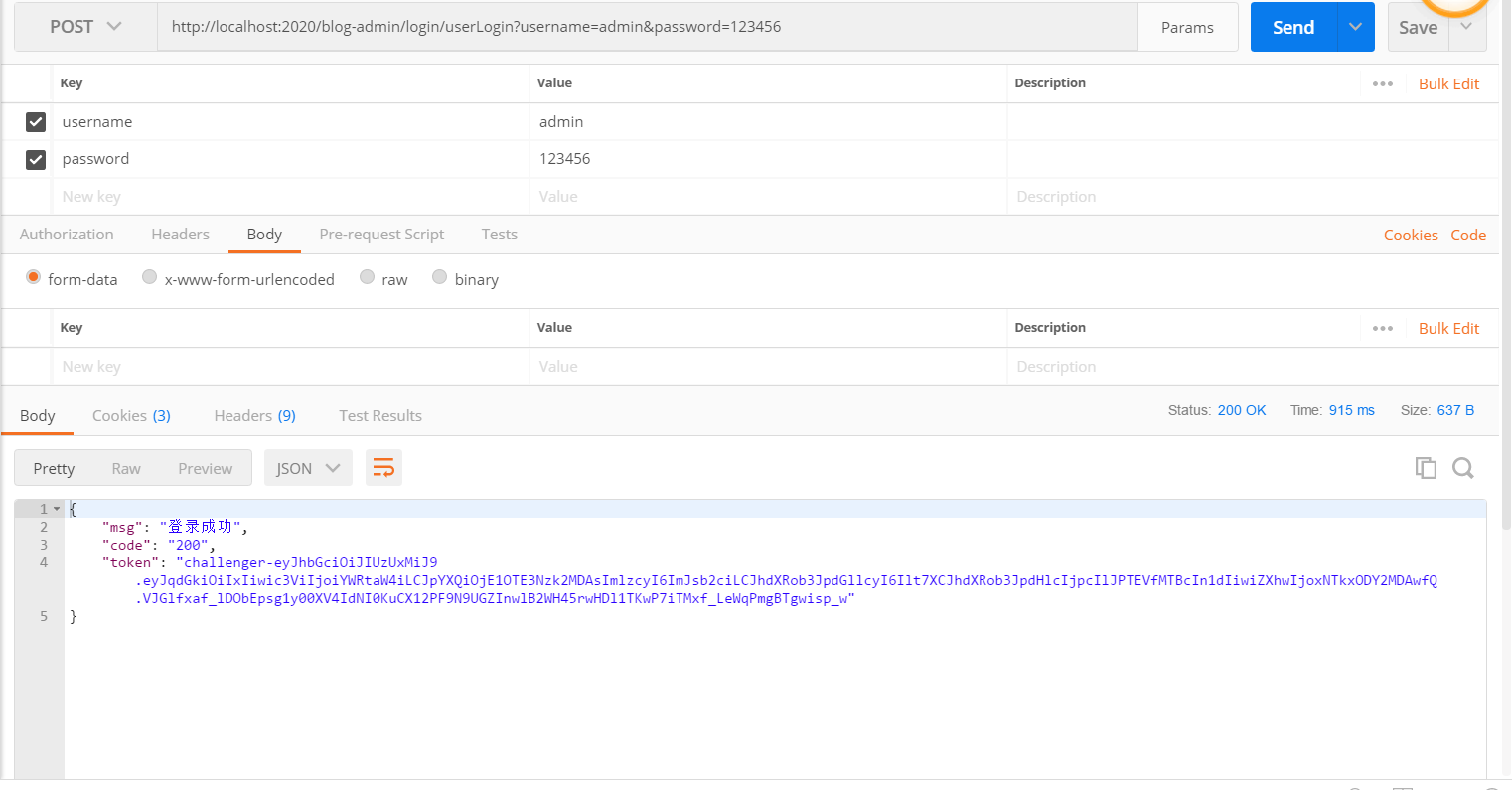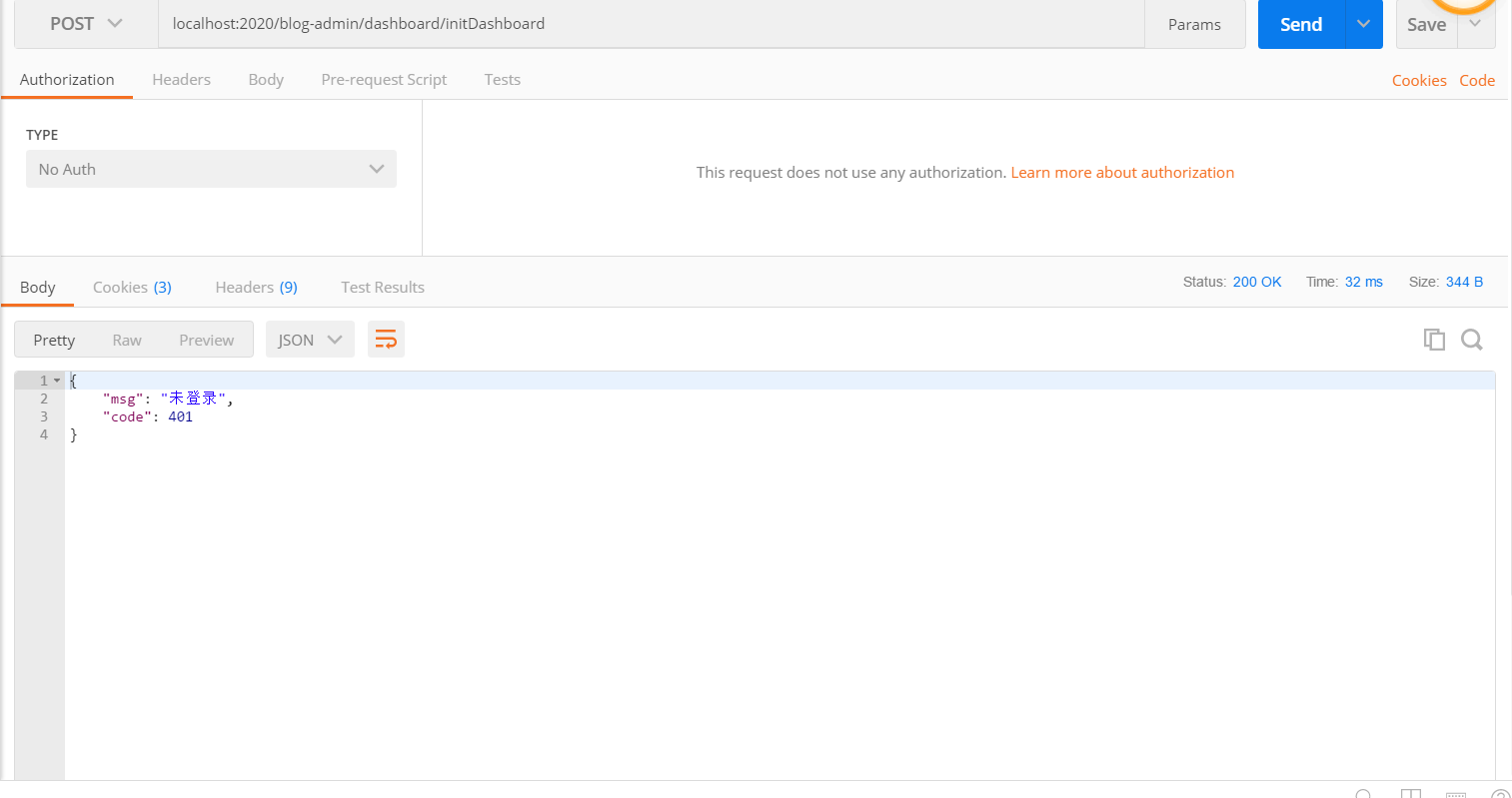SpringCloud之Security
Spring Security是Spring提供的一个安全框架,提供认证和授权功能,最主要的是它提供了简单的使用方式,同时又有很高的灵活性,简单,灵活,强大。
我个人博客系统采用的权限框架就是Spring Security,正好整合到SpringCloud里面。
一般系统里关于角色方面通常有这么几张表,角色表、用户-角色表、菜单表、角色-菜单表等。
不过我个人博客系统主要以wordpress作为参考,沿用其12张表,如图:

一、导入Maven依赖
<properties>
<jjwt.version>0.9.0</jjwt.version>
<spring-security-jwt.version>1.0.9.RELEASE</spring-security-jwt.version>
</properties>
<!-- springsecurity-->
<dependency>
<groupId>org.springframework.boot</groupId>
<artifactId>spring-boot-starter-security</artifactId>
</dependency>
<dependency>
<groupId>org.springframework.security</groupId>
<artifactId>spring-security-jwt</artifactId>
<version>${spring-security-jwt.version}</version>
</dependency>
<dependency>
<groupId>io.jsonwebtoken</groupId>
<artifactId>jjwt</artifactId>
<version>${jjwt.version}</version>
</dependency>
二、编写Spring Security配置类
package com.springcloud.blog.admin.config; import com.springcloud.blog.admin.security.UserAuthenticationProvider; import com.springcloud.blog.admin.security.UserPermissionEvaluator; import com.springcloud.blog.admin.security.handler.*; import com.springcloud.blog.admin.security.jwt.JWTAuthenticationTokenFilter; import org.springframework.beans.factory.annotation.Autowired; import org.springframework.context.annotation.Bean; import org.springframework.context.annotation.Configuration; import org.springframework.security.config.annotation.authentication.builders.AuthenticationManagerBuilder; import org.springframework.security.config.annotation.method.configuration.EnableGlobalMethodSecurity; import org.springframework.security.config.annotation.web.builders.HttpSecurity; import org.springframework.security.config.annotation.web.configuration.EnableWebSecurity; import org.springframework.security.config.annotation.web.configuration.WebSecurityConfigurerAdapter; import org.springframework.security.config.http.SessionCreationPolicy; import org.springframework.security.crypto.bcrypt.BCryptPasswordEncoder; import org.springframework.security.web.access.expression.DefaultWebSecurityExpressionHandler; /** * SpringSecurity配置类 * @Author youcong */ @Configuration @EnableWebSecurity @EnableGlobalMethodSecurity(prePostEnabled = true) //开启权限注解,默认是关闭的 public class SecurityConfig extends WebSecurityConfigurerAdapter { /** * 自定义登录成功处理器 */ @Autowired private UserLoginSuccessHandler userLoginSuccessHandler; /** * 自定义登录失败处理器 */ @Autowired private UserLoginFailureHandler userLoginFailureHandler; /** * 自定义注销成功处理器 */ @Autowired private UserLogoutSuccessHandler userLogoutSuccessHandler; /** * 自定义暂无权限处理器 */ @Autowired private UserAuthAccessDeniedHandler userAuthAccessDeniedHandler; /** * 自定义未登录的处理器 */ @Autowired private UserAuthenticationEntryPointHandler userAuthenticationEntryPointHandler; /** * 自定义登录逻辑验证器 */ @Autowired private UserAuthenticationProvider userAuthenticationProvider; /** * 加密方式 * @Author youcong */ @Bean public BCryptPasswordEncoder bCryptPasswordEncoder(){ return new BCryptPasswordEncoder(); } /** * 注入自定义PermissionEvaluator */ @Bean public DefaultWebSecurityExpressionHandler userSecurityExpressionHandler(){ DefaultWebSecurityExpressionHandler handler = new DefaultWebSecurityExpressionHandler(); handler.setPermissionEvaluator(new UserPermissionEvaluator()); return handler; } /** * 配置登录验证逻辑 */ @Override protected void configure(AuthenticationManagerBuilder auth){ //这里可启用我们自己的登陆验证逻辑 auth.authenticationProvider(userAuthenticationProvider); } /** * 配置security的控制逻辑 * @Author youcong * @Param http 请求 */ @Override protected void configure(HttpSecurity http) throws Exception { http.authorizeRequests() // 不进行权限验证的请求或资源(从配置文件中读取) .antMatchers(JWTConfig.antMatchers.split(",")).permitAll() // .antMatchers("/*").permitAll() // 其他的需要登陆后才能访问 .anyRequest().authenticated() .and() // 配置未登录自定义处理类 .httpBasic().authenticationEntryPoint(userAuthenticationEntryPointHandler) .and() // 配置登录地址 .formLogin() .loginProcessingUrl("/login/userLogin") // 配置登录成功自定义处理类 .successHandler(userLoginSuccessHandler) // 配置登录失败自定义处理类 .failureHandler(userLoginFailureHandler) .and() // 配置登出地址 .logout() .logoutUrl("/login/userLogout") // 配置用户登出自定义处理类 .logoutSuccessHandler(userLogoutSuccessHandler) .and() // 配置没有权限自定义处理类 .exceptionHandling().accessDeniedHandler(userAuthAccessDeniedHandler) .and() // 开启跨域 .cors() .and() // 取消跨站请求伪造防护 .csrf().disable(); // 基于Token不需要session http.sessionManagement().sessionCreationPolicy(SessionCreationPolicy.STATELESS); // 禁用缓存 http.headers().cacheControl(); // 添加JWT过滤器 http.addFilter(new JWTAuthenticationTokenFilter(authenticationManager())); } }
三、编写JWTConfig和application.yml增加jwt相关配置
package com.springcloud.blog.admin.config; import lombok.Getter; import org.springframework.boot.context.properties.ConfigurationProperties; import org.springframework.stereotype.Component; /** * JWT配置类 * @Author youcong */ @Getter @Component @ConfigurationProperties(prefix = "jwt") public class JWTConfig { /** * 密钥KEY */ public static String secret; /** * TokenKey */ public static String tokenHeader; /** * Token前缀字符 */ public static String tokenPrefix; /** * 过期时间 */ public static Integer expiration; /** * 不需要认证的接口 */ public static String antMatchers; public void setSecret(String secret) { this.secret = secret; } public void setTokenHeader(String tokenHeader) { this.tokenHeader = tokenHeader; } public void setTokenPrefix(String tokenPrefix) { this.tokenPrefix = tokenPrefix; } public void setExpiration(Integer expiration) { this.expiration = expiration * 1000; } public void setAntMatchers(String antMatchers) { this.antMatchers = antMatchers; } }
application.yml增加如下内容:
# JWT配置 jwt: # 密匙KEY secret: JWTSecret # HeaderKEY tokenHeader: Authorization # Token前缀字符 tokenPrefix: challenger- # 过期时间 单位秒 1天后过期=86400 7天后过期=604800 expiration: 86400 # 配置不需要认证的接口 antMatchers: /index/**,/login/**,/favicon.ico # 有效时间 validTime: 7
四、编写过滤器处理类
1.UserLoginSuccessHandler.java
package com.springcloud.blog.admin.security.handler; import com.springcloud.blog.admin.config.JWTConfig; import com.springcloud.blog.admin.security.entity.SelfUserEntity; import com.springcloud.blog.admin.utils.AccessAddressUtil; import com.springcloud.blog.admin.utils.JWTTokenUtil; import com.springcloud.blog.admin.utils.RedisUtil; import com.springcloud.blog.admin.utils.ResultUtil; import org.springframework.beans.factory.annotation.Autowired; import org.springframework.security.core.Authentication; import org.springframework.security.web.authentication.AuthenticationSuccessHandler; import org.springframework.stereotype.Component; import javax.servlet.http.HttpServletRequest; import javax.servlet.http.HttpServletResponse; import java.util.HashMap; import java.util.Map; /** * @Description 登录成功处理类 * @Author youcong */ @Component public class UserLoginSuccessHandler implements AuthenticationSuccessHandler { /** * 登录成功返回结果 * @Author youcong */ @Override public void onAuthenticationSuccess(HttpServletRequest request, HttpServletResponse response, Authentication authentication){ // 组装JWT SelfUserEntity selfUserEntity = (SelfUserEntity) authentication.getPrincipal(); String token = JWTTokenUtil.createAccessToken(selfUserEntity); token = JWTConfig.tokenPrefix + token; // 封装返回参数 Map<String,Object> resultData = new HashMap<>(); resultData.put("code","200"); resultData.put("msg", "登录成功"); resultData.put("token",token); ResultUtil.responseJson(response,resultData); } }
2.UserLoginFailureHandler.java
package com.springcloud.blog.admin.security.handler; import com.springcloud.blog.admin.utils.ResultUtil; import org.springframework.security.authentication.BadCredentialsException; import org.springframework.security.authentication.LockedException; import org.springframework.security.core.AuthenticationException; import org.springframework.security.core.userdetails.UsernameNotFoundException; import org.springframework.security.web.authentication.AuthenticationFailureHandler; import org.springframework.stereotype.Component; import javax.servlet.http.HttpServletRequest; import javax.servlet.http.HttpServletResponse; /** * @Description 登录失败处理类 * @Author youcong */ @Component public class UserLoginFailureHandler implements AuthenticationFailureHandler { /** * 登录失败返回结果 * @Author youcong */ @Override public void onAuthenticationFailure(HttpServletRequest request, HttpServletResponse response, AuthenticationException exception){ // 这些对于操作的处理类可以根据不同异常进行不同处理 if (exception instanceof UsernameNotFoundException){ System.out.println("【登录失败】"+exception.getMessage()); ResultUtil.responseJson(response,ResultUtil.resultCode(500,"用户名不存在")); } if (exception instanceof LockedException){ System.out.println("【登录失败】"+exception.getMessage()); ResultUtil.responseJson(response,ResultUtil.resultCode(500,"用户被冻结")); } if (exception instanceof BadCredentialsException){ System.out.println("【登录失败】"+exception.getMessage()); ResultUtil.responseJson(response,ResultUtil.resultCode(500,"密码错误")); } ResultUtil.responseJson(response,ResultUtil.resultCode(500,"登录失败")); } }
3.UserLogoutSuccessHandler.java
package com.springcloud.blog.admin.security.handler; import com.springcloud.blog.admin.utils.DateUtil; import com.springcloud.blog.admin.utils.RedisUtil; import com.springcloud.blog.admin.utils.ResultUtil; import org.springframework.beans.factory.annotation.Autowired; import org.springframework.security.core.Authentication; import org.springframework.security.core.context.SecurityContextHolder; import org.springframework.security.web.authentication.logout.LogoutSuccessHandler; import org.springframework.stereotype.Component; import javax.servlet.http.HttpServletRequest; import javax.servlet.http.HttpServletResponse; import java.util.HashMap; import java.util.Map; /** * 登出成功处理类 * @Author youcong */ @Component public class UserLogoutSuccessHandler implements LogoutSuccessHandler { /** * 用户登出返回结果 * 这里应该让前端清除掉Token * @Author youcong */ @Override public void onLogoutSuccess(HttpServletRequest request, HttpServletResponse response, Authentication authentication){ Map<String,Object> resultData = new HashMap<>(); resultData.put("code","200"); resultData.put("msg", "登出成功"); SecurityContextHolder.clearContext(); ResultUtil.responseJson(response,ResultUtil.resultSuccess(resultData)); } }
4.UserAuthAccessDeniedHandler.java
package com.springcloud.blog.admin.security.handler; import com.springcloud.blog.admin.utils.ResultUtil; import org.springframework.security.access.AccessDeniedException; import org.springframework.security.web.access.AccessDeniedHandler; import org.springframework.stereotype.Component; import javax.servlet.http.HttpServletRequest; import javax.servlet.http.HttpServletResponse; /** * @Description 暂无权限处理类 * @Author youcong */ @Component public class UserAuthAccessDeniedHandler implements AccessDeniedHandler { /** * 暂无权限返回结果 * @Author youcong */ @Override public void handle(HttpServletRequest request, HttpServletResponse response, AccessDeniedException exception){ ResultUtil.responseJson(response,ResultUtil.resultCode(403,"未授权")); } }
5.UserAuthenticationEntryPointHandler.java
package com.springcloud.blog.admin.security.handler; import com.springcloud.blog.admin.utils.ResultUtil; import org.springframework.security.core.AuthenticationException; import org.springframework.security.web.AuthenticationEntryPoint; import org.springframework.stereotype.Component; import javax.servlet.http.HttpServletRequest; import javax.servlet.http.HttpServletResponse; /** * 用户未登录处理类 * @Author youcong */ @Component public class UserAuthenticationEntryPointHandler implements AuthenticationEntryPoint { /** * 用户未登录返回结果 * @Author youcong */ @Override public void commence(HttpServletRequest request, HttpServletResponse response, AuthenticationException exception){ ResultUtil.responseJson(response,ResultUtil.resultCode(401,"未登录")); } }
6.UserAuthenticationProvider.java
自定义登录验证这个类,需要根据实际情况重写。通常来说改动不大。
package com.springcloud.blog.admin.security; import com.baomidou.mybatisplus.mapper.EntityWrapper; import com.springcloud.blog.admin.entity.Usermeta; import com.springcloud.blog.admin.entity.Users; import com.springcloud.blog.admin.security.entity.SelfUserEntity; import com.springcloud.blog.admin.service.UsermetaService; import com.springcloud.blog.admin.service.UsersService; import org.springframework.beans.factory.annotation.Autowired; import org.springframework.security.authentication.AuthenticationProvider; import org.springframework.security.authentication.BadCredentialsException; import org.springframework.security.authentication.LockedException; import org.springframework.security.authentication.UsernamePasswordAuthenticationToken; import org.springframework.security.core.Authentication; import org.springframework.security.core.AuthenticationException; import org.springframework.security.core.GrantedAuthority; import org.springframework.security.core.authority.SimpleGrantedAuthority; import org.springframework.security.core.userdetails.UsernameNotFoundException; import org.springframework.security.crypto.bcrypt.BCryptPasswordEncoder; import org.springframework.stereotype.Component; import java.util.HashSet; import java.util.List; import java.util.Set; /** * 自定义登录验证 * * @Author youcong */ @Component public class UserAuthenticationProvider implements AuthenticationProvider { @Autowired private UsersService usersService; @Autowired private UsermetaService usermetaService; @Override public Authentication authenticate(Authentication authentication) throws AuthenticationException { // 获取表单输入中返回的用户名 String userName = (String) authentication.getPrincipal(); // 获取表单中输入的密码 String password = (String) authentication.getCredentials(); // 查询用户是否存在 SelfUserEntity userInfo = usersService.getUserInfo(userName); if (userInfo.getUsername() == null || userInfo.getUsername() == "") { throw new UsernameNotFoundException("用户名不存在"); } // 我们还要判断密码是否正确,这里我们的密码使用BCryptPasswordEncoder进行加密的 if (!new BCryptPasswordEncoder().matches(password, userInfo.getPassword())) { throw new BadCredentialsException("密码不正确"); } // 还可以加一些其他信息的判断,比如用户账号已停用等判断 if (userInfo.getStatus().equals("1")) { throw new LockedException("该用户已被冻结"); } // 角色集合 Set<GrantedAuthority> authorities = new HashSet<>(); EntityWrapper<Usermeta> roleWrapper = new EntityWrapper<>(); roleWrapper.eq("user_id",userInfo.getUserId()); roleWrapper.eq("meta_key","wp_user_level"); // 查询用户角色 List<Usermeta> sysRoleEntityList = usermetaService.selectList(roleWrapper); for (Usermeta sysRoleEntity: sysRoleEntityList){ authorities.add(new SimpleGrantedAuthority("ROLE_" + sysRoleEntity.getMetaValue())); } userInfo.setAuthorities(authorities); // 进行登录 return new UsernamePasswordAuthenticationToken(userInfo, password, authorities); } @Override public boolean supports(Class<?> authentication) { return true; } }
7.UserPermissionEvaluator.java
package com.springcloud.blog.admin.security; import com.baomidou.mybatisplus.mapper.EntityWrapper; import com.springcloud.blog.admin.entity.Usermeta; import com.springcloud.blog.admin.service.UsermetaService; import org.apache.catalina.User; import org.springframework.beans.factory.annotation.Autowired; import org.springframework.security.access.PermissionEvaluator; import org.springframework.security.core.Authentication; import org.springframework.stereotype.Component; import java.io.Serializable; import java.util.HashSet; import java.util.List; import java.util.Set; /** * 自定义权限注解验证 * @Author youcong */ @Component public class UserPermissionEvaluator implements PermissionEvaluator { @Autowired private UsermetaService usermetaService; /** * hasPermission鉴权方法 * 这里仅仅判断PreAuthorize注解中的权限表达式 * 实际中可以根据业务需求设计数据库通过targetUrl和permission做更复杂鉴权 * 当然targetUrl不一定是URL可以是数据Id还可以是管理员标识等,这里根据需求自行设计 * @Author youcong * @Param authentication 用户身份(在使用hasPermission表达式时Authentication参数默认会自动带上) * @Param targetUrl 请求路径 * @Param permission 请求路径权限 * @Return boolean 是否通过 */ @Override public boolean hasPermission(Authentication authentication, Object targetUrl, Object permission) { // 获取用户信息 Usermeta selfUserEntity =(Usermeta) authentication.getPrincipal(); // 查询用户权限(这里可以将权限放入缓存中提升效率) Set<String> permissions = new HashSet<>(); EntityWrapper<Usermeta> roleWrapper = new EntityWrapper<>(); roleWrapper.eq("user_id",selfUserEntity.getUserId()); roleWrapper.eq("meta_key","wp_user_level"); List<Usermeta> sysMenuEntityList = usermetaService.selectList(roleWrapper); for (Usermeta sysMenuEntity:sysMenuEntityList) { permissions.add(sysMenuEntity.getMetaValue()); } // 权限对比 if (permissions.contains(permission.toString())){ return true; } return true; } @Override public boolean hasPermission(Authentication authentication, Serializable targetId, String targetType, Object permission) { return false; } }
五、编写实体类
package com.springcloud.blog.admin.security.entity; import org.springframework.security.core.GrantedAuthority; import org.springframework.security.core.userdetails.UserDetails; import java.io.Serializable; import java.util.Collection; import java.util.Map; /** * SpringSecurity用户的实体 * 注意:这里必须要实现UserDetails接口 * * @Author youcong */ public class SelfUserEntity implements Serializable, UserDetails { private static final long serialVersionUID = 1L; /** * 用户ID */ private Long userId; /** * 用户名 */ private String username; /** * 密码 */ private String password; /** * 状态 */ private String status; /** * 显示名称 */ private String displayName; /** * 用户参数 */ private Map<String, String> userParamMap; /** * 用户角色 */ private Collection<GrantedAuthority> authorities; /** * 账户是否过期 */ private boolean isAccountNonExpired = false; /** * 账户是否被锁定 */ private boolean isAccountNonLocked = false; /** * 证书是否过期 */ private boolean isCredentialsNonExpired = false; /** * 账户是否有效 */ private boolean isEnabled = true; public static long getSerialVersionUID() { return serialVersionUID; } public Long getUserId() { return userId; } public void setUserId(Long userId) { this.userId = userId; } @Override public String getUsername() { return username; } public void setUsername(String username) { this.username = username; } @Override public String getPassword() { return password; } public void setPassword(String password) { this.password = password; } public void setAuthorities(Collection<GrantedAuthority> authorities) { this.authorities = authorities; } public void setEnabled(boolean enabled) { isEnabled = enabled; } public void setStatus(String status) { this.status = status; } public String getStatus() { return status; } public String getDisplayName() { return displayName; } public void setDisplayName(String displayName) { this.displayName = displayName; } public Map<String, String> getUserParamMap() { return userParamMap; } public void setUserParamMap(Map<String, String> userParamMap) { this.userParamMap = userParamMap; } @Override public Collection<GrantedAuthority> getAuthorities() { return authorities; } @Override public boolean isAccountNonExpired() { return isAccountNonExpired; } @Override public boolean isAccountNonLocked() { return isAccountNonLocked; } @Override public boolean isCredentialsNonExpired() { return isCredentialsNonExpired; } @Override public boolean isEnabled() { return isEnabled; } }
六、编写JWT接口请求拦截器
package com.springcloud.blog.admin.security.jwt; import com.alibaba.fastjson.JSON; import com.alibaba.fastjson.JSONObject; import com.springcloud.blog.admin.config.JWTConfig; import com.springcloud.blog.admin.security.entity.SelfUserEntity; import com.springcloud.blog.admin.utils.CollectionUtil; import com.springcloud.blog.admin.utils.JWTTokenUtil; import com.springcloud.blog.admin.utils.RedisUtil; import io.jsonwebtoken.Claims; import io.jsonwebtoken.ExpiredJwtException; import io.jsonwebtoken.Jwts; import org.springframework.beans.factory.annotation.Autowired; import org.springframework.security.authentication.AuthenticationManager; import org.springframework.security.authentication.UsernamePasswordAuthenticationToken; import org.springframework.security.core.GrantedAuthority; import org.springframework.security.core.authority.SimpleGrantedAuthority; import org.springframework.security.core.context.SecurityContextHolder; import org.springframework.security.web.authentication.www.BasicAuthenticationFilter; import org.springframework.util.StringUtils; import javax.servlet.FilterChain; import javax.servlet.ServletException; import javax.servlet.http.HttpServletRequest; import javax.servlet.http.HttpServletResponse; import java.io.IOException; import java.util.ArrayList; import java.util.List; import java.util.Map; /** * JWT接口请求校验拦截器 * 请求接口时会进入这里验证Token是否合法和过期 * * @Author youcong */ public class JWTAuthenticationTokenFilter extends BasicAuthenticationFilter { public JWTAuthenticationTokenFilter(AuthenticationManager authenticationManager) { super(authenticationManager); } @Override protected void doFilterInternal(HttpServletRequest request, HttpServletResponse response, FilterChain filterChain) throws ServletException, IOException { // 获取请求头中JWT的Token String tokenHeader = request.getHeader(JWTConfig.tokenHeader); if (null != tokenHeader && tokenHeader.startsWith(JWTConfig.tokenPrefix)) { try { // 截取JWT前缀 String token = tokenHeader.replace(JWTConfig.tokenPrefix, ""); // 解析JWT Claims claims = Jwts.parser() .setSigningKey(JWTConfig.secret) .parseClaimsJws(token) .getBody(); // 获取用户名 String username = claims.getSubject(); String userId = claims.getId(); if (!StringUtils.isEmpty(username) && !StringUtils.isEmpty(userId)) { // 获取角色 List<GrantedAuthority> authorities = new ArrayList<>(); String authority = claims.get("authorities").toString(); if (!StringUtils.isEmpty(authority)) { List<Map<String, String>> authorityMap = JSONObject.parseObject(authority, List.class); for (Map<String, String> role : authorityMap) { if (!StringUtils.isEmpty(role)) { authorities.add(new SimpleGrantedAuthority(role.get("authority"))); } } } //组装参数 SelfUserEntity selfUserEntity = new SelfUserEntity(); selfUserEntity.setUsername(claims.getSubject()); selfUserEntity.setUserId(Long.parseLong(claims.getId())); selfUserEntity.setAuthorities(authorities); UsernamePasswordAuthenticationToken authentication = new UsernamePasswordAuthenticationToken(selfUserEntity, userId, authorities); SecurityContextHolder.getContext().setAuthentication(authentication); } } catch (ExpiredJwtException e) { System.out.println("Token过期"); } catch (Exception e) { System.out.println("Token无效"); } } filterChain.doFilter(request, response); return; } }
七、SpringSecurity用户的业务实现
package com.springcloud.blog.admin.security.service; import com.baomidou.mybatisplus.mapper.EntityWrapper; import com.springcloud.blog.admin.entity.Users; import com.springcloud.blog.admin.security.entity.SelfUserEntity; import com.springcloud.blog.admin.service.UsersService; import org.springframework.beans.BeanUtils; import org.springframework.beans.factory.annotation.Autowired; import org.springframework.security.core.userdetails.UserDetailsService; import org.springframework.security.core.userdetails.UsernameNotFoundException; import org.springframework.stereotype.Component; /** * SpringSecurity用户的业务实现 * * @Author youcong */ @Component public class SelfUserDetailsService implements UserDetailsService { @Autowired private UsersService usersService; /** * 查询用户信息 * * @Author youcong * @Param username 用户名 * @Return UserDetails SpringSecurity用户信息 */ @Override public SelfUserEntity loadUserByUsername(String username) throws UsernameNotFoundException { EntityWrapper<Users> wrapper = new EntityWrapper<>(); //邮箱正则表达式 String expr = "^([a-zA-Z0-9_\\-\\.]+)@((\\[[0-9]{1,3}\\.[0-9]{1,3}\\.[0-9]{1,3}\\.)|(([a-zA-Z0-9\\-]+\\.)+))([a-zA-Z]{2,4}|[0-9]{1,3})$"; //是否为邮箱 if (username.matches(expr)) { wrapper.eq("user_email", username); } else { wrapper.eq("user_login", username); } // 查询用户信息 Users sysUserEntity = usersService.selectOne(wrapper); if (sysUserEntity != null) { // 组装参数 SelfUserEntity selfUserEntity = new SelfUserEntity(); BeanUtils.copyProperties(sysUserEntity, selfUserEntity); return selfUserEntity; } return null; } }
八、Spring Security常用注解
1.@Secured
当@EnableGlobalMethodSecurity(securedEnabled=true)的时候,@Secured可以使用。
@PostMapping("/helloUser") @Secured({"ROLE_normal","ROLE_admin"}) public Map<String, Object> initDashboard() { Map<String, Object> result = new HashMap<>(); result.put(ResponseDict.RESPONSE_TITLE_KEY, "仪表盘初始化"); result.put(ResponseDict.RESPONSE_DATA_KEY, dashboardService.initDashboard()); return ResultUtil.resultSuccess(result); }
说明:拥有normal或者admin角色的用户都可以方法helloUser()方法。另外需要注意的是这里匹配的字符串需要添加前缀“ROLE_“。
Spring的 @PreAuthorize/@PostAuthorize 注解更适合方法级的安全,也支持Spring 表达式语言,提供了基于表达式的访问控制。
当@EnableGlobalMethodSecurity(prePostEnabled=true)的时候,@PreAuthorize可以使用:
@PostMapping("/initDashboard") @PreAuthorize("hasRole('100')") public Map<String, Object> initDashboard() { Map<String, Object> result = new HashMap<>(); result.put(ResponseDict.RESPONSE_TITLE_KEY, "仪表盘初始化"); result.put(ResponseDict.RESPONSE_DATA_KEY, dashboardService.initDashboard()); return ResultUtil.resultSuccess(result); }
@PostAuthorize 注解使用并不多,在方法执行后再进行权限验证,适合验证带有返回值的权限,Spring EL 提供 返回对象能够在表达式语言中获取返回的对象returnObject。
当@EnableGlobalMethodSecurity(prePostEnabled=true)的时候,@PostAuthorize可以使用:
@GetMapping("/getUserInfo") @PostAuthorize(" returnObject!=null && returnObject.username == authentication.name") public User getUserInfo() { Object pricipal = SecurityContextHolder.getContext().getAuthentication().getPrincipal(); User user; if("anonymousUser".equals(pricipal)) { user = null; }else { user = (User) pricipal; } return user; }
九、测试
(1)登录测试,拿到token,如图:

(2)请求中如果不携带token的话,请求其它接口就会显示没有登录的提示,如图:

(3)正确的请求应当携带token,就像下面这样,如图:

(4)没有权限请求,如图:











【推荐】国内首个AI IDE,深度理解中文开发场景,立即下载体验Trae
【推荐】编程新体验,更懂你的AI,立即体验豆包MarsCode编程助手
【推荐】抖音旗下AI助手豆包,你的智能百科全书,全免费不限次数
【推荐】轻量又高性能的 SSH 工具 IShell:AI 加持,快人一步
· 如何编写易于单元测试的代码
· 10年+ .NET Coder 心语,封装的思维:从隐藏、稳定开始理解其本质意义
· .NET Core 中如何实现缓存的预热?
· 从 HTTP 原因短语缺失研究 HTTP/2 和 HTTP/3 的设计差异
· AI与.NET技术实操系列:向量存储与相似性搜索在 .NET 中的实现
· 周边上新:园子的第一款马克杯温暖上架
· Open-Sora 2.0 重磅开源!
· 分享 3 个 .NET 开源的文件压缩处理库,助力快速实现文件压缩解压功能!
· Ollama——大语言模型本地部署的极速利器
· [AI/GPT/综述] AI Agent的设计模式综述
2018-06-10 shiro实战系列(六)之Authorization(授权)
2018-06-10 springmvc与ajax交互常见问题